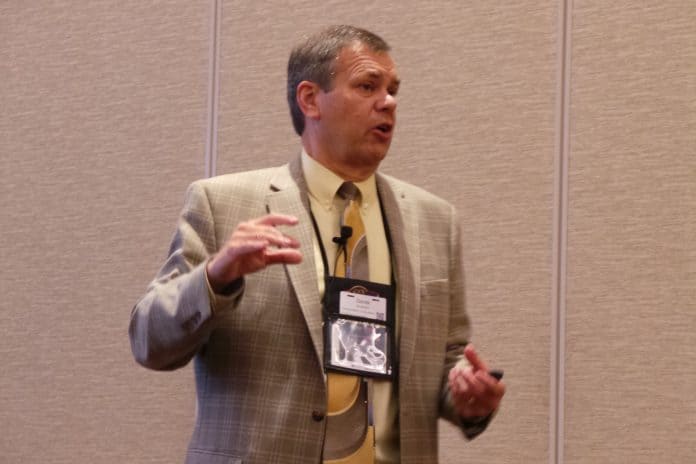INDIANAPOLIS — Facilitator Derek Graham, an industry consultant and former state director in North Carolina for 21 years, opened the Sunday morning session during the STN EXPO Indy with a brief review of early school bus seatbelt test demonstrations, and then progressed through seating options, seat-back height and passenger capacity. His two panelists also reported on the more dangerous environment that both school bus drivers and their passengers now face.
Today, only four states currently require three-point seat belts on newly purchased school buses. Elsewhere, a number of individual school districts that are scattered across the country have implemented similar requirements.
In 2007, then U.S. Department of Transportation Secretary Mary Peters came to North Carolina and announced that the height of school bus seat backs had to increase, and that lap-shoulder belts would be required for buses weighing less than 10,000 pounds. It helped that states could use federal “402” highway funds to meet the requirements, Graham noted.
That same year, school bus seating manufacturers began providing the industry with new “flex” technology that allows three smaller children or two larger children to sit on a bench seat, the new standard to address concerns about passenger capacity reductions.
At the time, California was the only state to require lap-shoulder seatbelts on all school buses, small and large.
Then last year, New Jersey changed its long-standing law that allowed two-point lap seatbelts into a lap-shoulder belt requirement. In 2017, Nevada passed a new law that requires new school buses purchased after July 1, 2019, to come equipped with lap-shoulder belts. Texas did the same, but it allows local school boards to opt-out if it explains in a public meeting that the school district simply can’t afford to do so. Many districts, however, have specified the occupant restraints on new purchases.
Also, in 2017, Arkansas acted to require that new school buses come with lap-shoulder belts, if 10 percent of local voters petition for it to be included on the ballot and then a majority pass the measure.
In Tennessee, Graham said there are now grants available for lap-shoulder belts. States that have schools or districts with the three-point belts are scattered throughout all 50 states, he added.
Tom Cohn, director of transportation for Helena Public Schools in Montana, reported on the wide-spread impact of a one-hour PBS documentary that aired in May 2017. It noted that 50 years after seat belts were first required in passenger cars, they still are not required nationwide for school buses. The bus transporters featured in the PBS program attributed that situation to the additional cost. “It’s as simple as that,” one interviewee noted.
“We have been trying to pass seatbelt legislation for the past 10 years. [But] you don’t hear about the kid with a broken eye socket,” Cohn noted. “Only the fatalities.”
Cohn next showed video from a school bus crash test conducted by IMMI in August 2017 at its Center for Advanced Product Evaluation. The exercise demonstrated a side impact bus-truck accident that ejected an un-belted student through a window. Cohn stressed that school bus floors and sides are constructed with hard steel, and the bus has many glass windows, so the safest equipment is the padded seats.
Unfortunately, Cohn commented, even the uniformly professional school drivers nationwide are often unable to prevent a speeding concrete truck from running a red light and crashing into the side of the bus. Compartmentalization keeps students within the seated area in frontal and rear-impact crashes, but fails during a side impact or rollover.
Cohn then showed video from a bus crash, during which practically all of the students were thrown from one side of the vehicle to the other. The unbelted passengers all collided into each other at the same time, as well as slammed into the sides of the bus.
Helena, Montana, in the 1970s, had four school bus routes, whereas today there are about 70. “Our environment today is a more dangerous environment, it just is,” Cohn added, especially because of the continuous usage of phones.
However, in Helena, there have been zero fatalities in recent years. “Because of seat belts, those kids are still on earth,” he remarked.
Cohn recounted a Nov. 27, 2017 crash, when at 7:13 a.m. a Helena school bus collided with a 1998 Dodge Ram pickup truck at an intersection. The school bus rolled over. The National Transportation Safety Board attributed the lack of fatalities to the three-point seat belts that were being used. “The restraints were effective and limited occupant-to-occupant contact, even during the rollover event,” the report stated.
Cohn pointed out that the bus traveled over 170 feet after impact.
“When you look in a mirror, are you going to see what I see?” Cohn asked, referring to the smile on his face. He called Montana’s school buses the “safest in the country,” since now they all have seat belts.
Meanwhile, panelist Bob Downin reported on his experience at Clark Pleasant School Corporation in Indianapolis, where the “tremendous success” of lap-shoulder belts has resulted in considerably better student behavior, which has led to improved driver retention.
“[But the]superintendent will always ask, how much does it cost,” noted the director of transportation.
“We actually spend less money than we did before,” Downin continued, explaining that the cost of vehicle insurance has dropped by implementing the seat belts, as well as video cameras. “Our routes are on-time, because the drivers don’t have to pull over to use discipline on some students.”
Clark Pleasant has a five-step process when it comes to student discipline, which includes a phone call home to explain the issue to parents, followed by a mailed letter and finally termination of bus riding privileges.
The improved driver retention rate has also substantially improved, which Downin directly attributed to the installation of lap-shoulder belts.
















